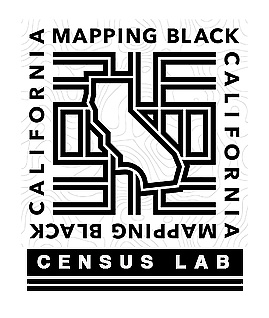California Black Hard To Count Map
To more effectively target the hardest to count Black population in California with relevant messaging that will inform, educate, and motivate Black people towards participating in the 2020 Census, the Voice Media Ventures team created the California Black Hard-to-Count Map (BLK-CA-HTC). In the BLK-CA-HTC Map, census tracts in California are each assigned a Black Hard-to-Count Score. Following our methodology, the Black Hard-to-Count score is a metric that incorporates 15 variables that traditionally correlate with areas where the Black population is difficult to enumerate.
Following the lead of the California Census Office Hard-To-Count Interactive Map, which takes into account indicators that have been historically correlated with undercounts as well as indicators associated with new barriers to enumeration, the BLK-CA-HTC is based on multiple demographic, housing, and socioeconomic variables correlated with an area being difficult to enumerate for the Black Population. Census tracts with higher BLK-CA-HTC scores are likely to be areas that will pose significant challenges to enumerate in 2020, while tracts with lower scores should be easier to count.
To calculate the BLK-CA-HTC score for California’s 8,057 census tracts, Black population ACS data was collected for each variable. Each of the below variables was sorted from high to low (e.g. sorted tracts from the highest percent of Black unemployed to the lowest.)
Next, each variable was assigned a value of 0-10. The highest values were recorded as 10, down to the lowest values, which were assigned a value of 0 (e.g. values of 10 were given to tracts with the highest Black unemployment rates and values of 0 were given to tracts below the California Black unemployment tract median.) The sum of the 15 values represent a tract’s BLK-CA-HTC Score.
Below are short descriptions of the 15 variables that comprise the BLK-CA-HTC Score (with data source):
Black population density ( Black or African American Alone )
(Table B01001B, U.S. Census Bureau 2013-2017 American Community Survey [ACS])
Percent of the Black population under 5 yrs
(Table B01001B, U.S. Census Bureau 2013-2017 American Community Survey [ACS])
Percent of the Black population between 18 yrs – 24 yrs
(Table B01001B, U.S. Census Bureau 2013-2017 American Community Survey [ACS])
Percent of the Black population in poverty
(Table B17001B, U.S. Census Bureau 2013-2017 American Community Survey [ACS])
Percent of Black adults (25 yrs or older) who are not high-school graduates
(Table C15002B, U.S. Census Bureau 2013-2017 American Community Survey [ACS])
Percent of Black households receiving food stamps in past 12 months
(Table B22005B, U.S. Census Bureau 2013-2017 American Community Survey [ACS])
Percent of Black persons (ages 16 or older) unemployed
(Table C23002B, U.S. Census Bureau 2013-2017 American Community Survey [ACS])
Percent of total housing units that are vacant
(Table B25002, U.S. Census Bureau 2013-2017 American Community Survey [ACS])
Percent of occupied housing units that are Black renter-occupied
(Table B25003B, U.S. Census Bureau 2013-2017 American Community Survey [ACS])
Percent of Black female head of households
(Table B11001B, U.S. Census Bureau 2013-2017 American Community Survey [ACS])
Percent of Black complex households
(Table B11001B, B10051B, U.S. Census Bureau 2013-2017 American Community Survey [ACS])
Percent of Black households that are non-family
(Table B11001B, U.S. Census Bureau 2013-2017 American Community Survey [ACS])
Percent of total Black housing units with 3 or more units in a multi-unit structure
(Table B25032B, U.S. Census Bureau 2013-2017 American Community Survey [ACS])
Percent of Black crowded housing
(Table B25014B, U.S. Census Bureau 2013-2017 American Community Survey [ACS])
Percent of households without internet
